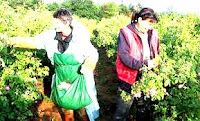loading...
METHODS OF HARVESTING
On this occasion Ahli Artikel will distribute articles about Methods Of Harvesting. Please see explanation below. . .
Methods of Harvesting
In the harvest of grain, the hand sickle, scythe, and cradle were replaced by the reaper, which was widely used until the modern binder was put on the market between 1880 and 1890. The header introduced still greater economies in the harvest of small grains. Now combines are generally used in the important grain-growing regions of the world.
Binder: Small grain harvested with a binder is tied in bundles and shocked in the field. Shocked grain is ordinarily left in the field for 10 days or more to cure before threshing. When considerable time is to lapse before it is trashed, the bundles may be stacked.
Header: The header formerly was used on large farms in the drier sections of the United States. It cut off the heads with usually 12 to 16 inches of attached straw, and elevated the material into a header barge, in which it was hauled to a stack or directly to a thresher.
Combine: The combine or combined harvester-thresher has been used in the Pacific Coast states for the harvest of wheat and barley since about 1880. Its use spread into the intermountain states somewhat later. It was introduced into the Great Plains states during World War I and is now used in every grain-growing state in the union. Combines are used for the harvest of nearly all small grain, grain sorghum, flax, soybeans, cowpeas, and safflower in the United States. It was used also in harvesting about 95 per cent of the dry peas, beans, and seed crops of the forage legumes and grasses by 1960. About 20 per cent of the combine harvesting was done by custom operators. With special attachments, the combine also harvest and shells corn.
The combined is essentially a threshing machine attached to a header. The larger sizes with 12-foot to 20-foot cutter bars are self-propelled, or are tractor-drawn and equipped with an auxiliary motor to operate the thresher mechanism. The smaller sizes with cutter bars 6 to 10 feet in length are often operated with a direct power drive from the tractor used to pull the machine. The grain is collected in a tank from which it its spouted into a wagon or truck. The straw usually is spread evenly over the ground. Where it is desired to save the straw for feed or bedding, it may be deposited in piles or windrows.
Thus the explanations about Methods Of Harvesting article. May be useful.
HAPPY LEARNING .. . . .
SOURCE:
Book Principles of Field Crop Production | John H. Martin - Warren H. Leonard | COLLIER Macmillan (1967)
On this occasion Ahli Artikel will distribute articles about Methods Of Harvesting. Please see explanation below. . .
Methods of Harvesting
In the harvest of grain, the hand sickle, scythe, and cradle were replaced by the reaper, which was widely used until the modern binder was put on the market between 1880 and 1890. The header introduced still greater economies in the harvest of small grains. Now combines are generally used in the important grain-growing regions of the world.
Binder: Small grain harvested with a binder is tied in bundles and shocked in the field. Shocked grain is ordinarily left in the field for 10 days or more to cure before threshing. When considerable time is to lapse before it is trashed, the bundles may be stacked.
Header: The header formerly was used on large farms in the drier sections of the United States. It cut off the heads with usually 12 to 16 inches of attached straw, and elevated the material into a header barge, in which it was hauled to a stack or directly to a thresher.
Combine: The combine or combined harvester-thresher has been used in the Pacific Coast states for the harvest of wheat and barley since about 1880. Its use spread into the intermountain states somewhat later. It was introduced into the Great Plains states during World War I and is now used in every grain-growing state in the union. Combines are used for the harvest of nearly all small grain, grain sorghum, flax, soybeans, cowpeas, and safflower in the United States. It was used also in harvesting about 95 per cent of the dry peas, beans, and seed crops of the forage legumes and grasses by 1960. About 20 per cent of the combine harvesting was done by custom operators. With special attachments, the combine also harvest and shells corn.
The combined is essentially a threshing machine attached to a header. The larger sizes with 12-foot to 20-foot cutter bars are self-propelled, or are tractor-drawn and equipped with an auxiliary motor to operate the thresher mechanism. The smaller sizes with cutter bars 6 to 10 feet in length are often operated with a direct power drive from the tractor used to pull the machine. The grain is collected in a tank from which it its spouted into a wagon or truck. The straw usually is spread evenly over the ground. Where it is desired to save the straw for feed or bedding, it may be deposited in piles or windrows.
Thus the explanations about Methods Of Harvesting article. May be useful.
HAPPY LEARNING .. . . .
SOURCE:
Book Principles of Field Crop Production | John H. Martin - Warren H. Leonard | COLLIER Macmillan (1967)
 |
| Picture Of Methods Of Harvesting |
loading...